With Christmas on the horizon and the new year just a few weeks away, I thought a little gemstone celebration is in order. So this month, instead of featuring a single birthstone, or even two, I decided to highlight THREE December stones this month. December is closely associated with fresh snowfalls and twinkling snowflakes (this is before we are all tired of driving through the slush, snow, and ice). The romance of the crisp winter season is beautifully tied up in the clear blue hues of December’s birthstones.
![]()
Blue Zircon
![]()
Blue zircon was the original December birthstone. Blue zircon is an intense blue gemstone. Of all the blue gemstones, including sapphire, topaz, and tanzanite, blue zircon has the highest refractive index. The refractive index helps gemologists identify stones. When light enters a gemstone, it slows down, because the stone is denser than air. Inside the stone, the light is bent through the crystalline structure, which gives gemstones their characteristic sparkle and shine. The higher the index, this more sparkle a stone has. So a diamond is a higher refractive index than, say, clear quartz or rock crystal. Lapidaries (professional gem cutters) can enhance this natural phenomenon by cutting facets into the crystal. A cut and polished gemstone will always sparkle and shine more than its rough counterparts.
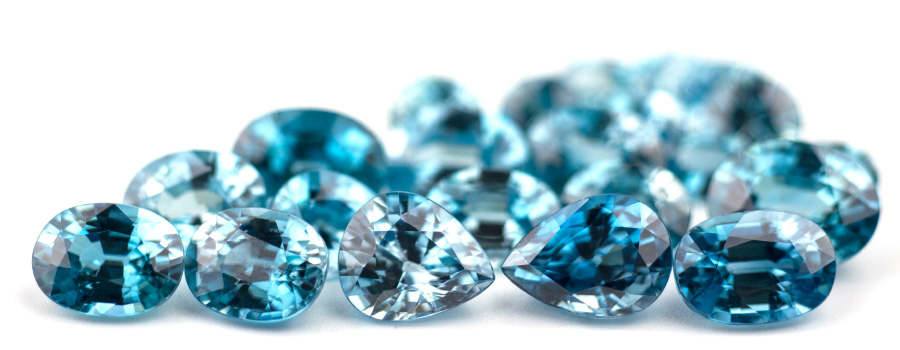
A group of faceted blue zircon gemstones
Blue zircon should not be confused with cubic zirconia. Zircon is a gemstone, while cubic zirconia is not. Many people may not readily recognize that they are different, with blue zircon enjoying popularity among gemstone lovers, but not necessarily all jewelry wearers. No matter the level of familiarity they have with blue zircon, most people easily recognize blue topaz as a birthstone of December.
![]()
Blue Topaz
![]()
We talked quite a bit about topaz as a gemstone in November, but blue topaz deserves its own conversation. Blue topaz is one of, if not the absolute most, popular varieties of topaz. That wasn’t always the case. Until the 1970s, most topaz that was commercially available was brown or yellow. Blue topaz does occur naturally, but it is very rare, and therefore, it was very expensive. However, in the ‘70s, it was discovered that clear topaz (which is plentiful and inexpensive) could be treated to exhibit a variety of blue hues. Since that time, the price of blue topaz has fallen to be one of the most affordable gemstones.
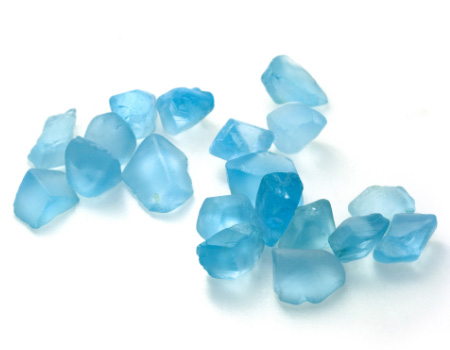 |
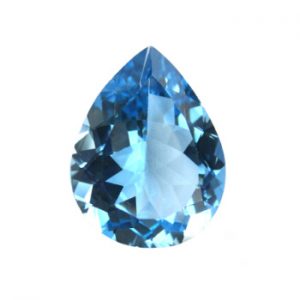 |
| Rough, uncut blue topaz crystals (left) and a faceted pear cut blue topaz (right) | |
But not all blue topaz is created equal. Blue topaz’s most illustrious shade is the London Blue Topaz. London Blue is a delightful deep shade of grayish blue. It’s reminiscent of the cloudy and rainy skies associated with the English countryside. The other juggernaut of blue topaz is the Swiss Blue. That is the clear, sky blue color we most often associate with blue topaz. The London Blue hue is more popular; therefore it is slightly more expensive.
![]()
Tanzanite
![]()
The mid-1900s were a good time for gemstone aficionados. In the 1967, a breathtaking gemstone was discovered: tanzanite. Tanzanite is an incredibly beautiful purplish-blue stone with a medium saturation of color. Tanzanite, unsurprisingly, was named after the country in which its discovery was made. Tanzania is an East African country that is famed for this lovely gemstone and the Serengeti and Kilimanjaro National Parks. What may surprise you is that famed jewelry house Tiffany & Co is responsible for the name tanzanite. Tanzanite, gemologically speaking, is blue-violet zoisite, but the folks over at Tiffany, correctly, thought that might be a bit cumbersome for the average consumer to request the jewelry counter. So the name paying homage to its origins was bestowed upon the stone.
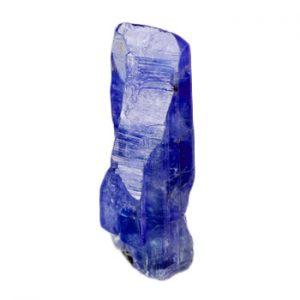 |
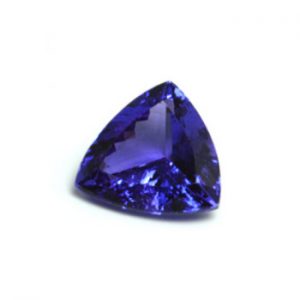 |
| A rough, uncut tanzanite crystal (left) and a faceted trillion cut tanzanite (right) | |
Tanzanite is a pretty big deal, in terms of availability, because the only known source of the gemstone is in Tanzania. Once the mines are empty, they are empty. And at present, we know of no other commercially viable sources of raw tanzanite. Additionally, the American Gem Trade Association changed their official endorsement of December’s birthstone to tanzanite in 2002. That changed marked the first change to their birthstone list in 90 years. To be fair though, you can find a wealth of difference of opinion when it comes to which stone represents which month. For my money, I err on the side of “the more the merrier.”
Essentially, if you are a December baby or you are shopping for a December baby, you cannot go wrong with blue zircon, blue topaz, or tanzanite.
Until next time,
Rebecca





